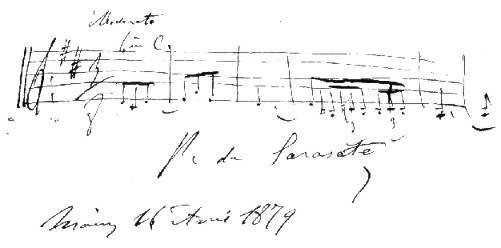Pablo de Sarasate(1844 - 1908) |

|
Biography
Pablo de Sarasate(1844 - 1908) |

|
Biography
But if you move about the city, perhaps in the vacinity of the music conservatory, you might also discover that on this day another sort of fiesta is celebrated — a fiesta in honor of one of Pamplona's most famous sons, Pable de Sarasate, violinist and composer.
Born Pablo Martín Melitón de Sarasate y Navascuéz in Pamplona, in the Spanish province of Navarre, on 10 March 1844, Pablo began studying violin at the age of five with his father, an artillery bandmaster. Later he took lessons from a local teacher. He gave his first concert at La Caruña when he was only eight years old.
Having been received with enthusiasm by his early audiences, Pablo was provided funding by a wealthy patron so that his parents could take him to Madrid to study with Manuel Rodríguez Saez. It was not long after his arrival that the young violinist became a favorite performer at the court of Queen Isabel II.
When Pablo was twelve, his mother decided to take him to Paris to study with the famous teacher Jean Alard at the Paris Conservatoire. The lad and his mother boarded a train for Paris, but tragedy befell them soon after they had crossed the French border. Pablo's mother was seized by a heart attack and died; and when taken by the Spanish authorities in Bayonne, Pablo was found to be suffering from cholera.
Fortunately, the Spanish consul at Bayonne took Pablo into his own home until he recovered, and he then financed the lad's trip on to Paris. Once in Paris, Pablo auditioned for Monsieur Alard, who immediately saw in the young Spaniard a gift of true musicianship.
Although the youthful violinist could easily have won all the honors of the Conversatoire shortly after he arrived, his prudent teacher held him back. But when Pablo was seventeen, Alard agreed to let him enter the competitions for the coveted Premiere Prix. Sarasate easily won. With the Conservatoire's highest honor, he was virtually guaranteed a career as a performer.
At the beginning of his career, Sarasate performed opera fantasies (most notably the Carmen fantasy) and other pieces that he himself had composed. Most of his compositions ring with a Spanish flavor, and it was largely because of Sarasate that Spanish music gained great favor among the notable European composers of that day. One need only listen to such famous works as Lalo's Symphonie espagnole (dedicated to Sarasate), Bizet's Carmen, and Saint-Saëns' Introduction and Rondo Capriccioso (also dedicated) to hear the clear influence of Spanish music and these distinguished composers.
George Bernard Shaw once said that though there were many composers of music for the violin, there were but few composers of violin music. But of Sarasate's talents, both as performer and composer, he said that he "left criticism gasping miles behind him." Indeed, Sarasate's four volumes of Spanish dances for violin and piano have been favorites for generations, and his Zigeunerweisen for violin and orchestra is even today a concert standard.
Sarasate was a true Spanish gentleman and was always impeccably dressed. Although he received literally thousands of love letters in his lifetime, he ignored them all and remained a bachelor. He was, however, most courtly in manners toward the fairer sex and conducted himself as a traditional Spanish caballero. It is said that he always kept a supply of Spanish fans to present to his lady admirers after concerts.
Though Sarasate became quite wealthy, he was also quite generous. He did purchase a villa in Biarritz, but every year he would return to his hometown to celebrate the Fiesta. While he would watch from a balcony as the bulls charged through the streets beneath him, the citizens would cheer their native son. And when Sarasate died of chronic bronchitis at his Biarritz home in 1908, he left most of his earthly goods to the city of Pamplona, where there now stands a special Sarasate museum in the conservatory. But his memory and his music he left to the world.

| Opus | Composition | Instrumentation |
| — | Fantaisie Caprice | Violin & piano |
| — | Souvenir de Faust | Violin & piano |
| — | Mazurka Mi | Violin & piano |
| No. 1 | Fantasy on La forza del destino | Violin & piano |
| No. 2 | Homenaje a Rossini | Violin & piano |
| No. 3 | La dame blanche de Boildieu | Violin & orchestra |
| No. 4 | Réverie | Violin & piano |
| No. 5 | Fantasy on Romeo and Juliette | Violin & piano |
| No. 6 | Caprice on Mireille | Violin & piano |
| No. 7 | Confidences | Violin & piano |
| No. 8 | Souvenir de Domont | Violin & piano |
| No. 9 | Les Adieux | Violin & piano |
| No. 10 | Sérénade Andalouse | Violin & piano |
| No. 11 | Le sommeil | Violin & piano |
| No. 12 | Moscoviènne | Violin & piano |
| No. 13 | New Fantasy on Faust | Violin & orchestra |
| No. 14 | Fantasy on Der Freischütz | Violin & orchestra |
| No. 15 | Mosaíque de Zampa | Violin & piano |
| No. 16 | Gavota on Mignon | Violin & piano |
| No. 17 | Priére at Berceuse | Violin & piano |
| No. 18 | Airs espagnols | Violin & piano |
| No. 19 | Fantasy on Martha | Violin & piano |
| No. 20 | Zigeunerweisen | Violin & orchestra |
| No. 21 | Malagueña y Habanera | Violin & piano |
| No. 22 | Romanza andaluza y jota navarra | Violin & piano |
| No. 23 | Playera y zapateado | Violin & piano |
| No. 24 | Capricho vasco | Violin & piano |
| No. 25 | Fantasy on Carmen | Violin & orchestra |
| No. 26 | Vito y habanera | Violin & piano |
| No. 27 | Jota aragonesa | Violin & piano |
| No. 28 | Serenata andaluza | Violin & piano |
| No. 29 | El canto del ruiseñor | Violin & orchestra |
| No. 30 | Bolero | Violin & piano |
| No. 31 | Balada | Violin & piano |
| No. 32 | Muñeira | Violin & orchestra |
| No. 33 | Navarra | Violin & orchestra |
| No. 34 | Airs Écossais | Violin & orchestra |
| No. 35 | Peteneras, caprice espagnol | Violin & piano |
| No. 36 | Jota de San Fermín | Violin & piano |
| No. 37 | Zortzico Adiós montañas mías | Violin & piano |
| No. 38 | Viva Sevilla! | Violin & orchestra |
| No. 39 | Zortzico de Iparraguirre | Violin & piano |
| No. 40 | Introduction et fandango varié | Violin & piano |
| No. 41 | Introduction et caprice-jota | Violin & orchestra |
| No. 42 | Zortzico Miramar | Violin & orchestra |
| No. 43 | Introduction et tarantelle | Violin & orchestra |
| No. 44 | La chase | Violin & orchestra |
| No. 45 | Nocturno — Serenata | Violin & orchestra |
| No. 46 | Gondoliéra Veneziana | Violin & piano |
| No. 47 | Melodía rumana | Violin & piano |
| No. 48 | K'Esprit Follet | Violin & orchestra |
| No. 49 | Canciones rusas | Violin & orchestra |
| No. 50 | Jota de Pamplona | Violin & orchestra |
| No. 51 | Fantasy on Don Giovanni | Violin & piano |
| No. 52 | Jota de Pablo | Violin & orchestra |
| No. 53 | La Rève | Violin & piano |
| No. 54 | Fantasy on Die Zauberflöte | Violin & orchestra |
Find sheet music of Sarasate's works at:
 |
 |
Return to Biographies
This page designed and maintained by John Craton.
Copyright © 1997-2009 by John Craton
Please e-mail any comments, additions, or corrections.